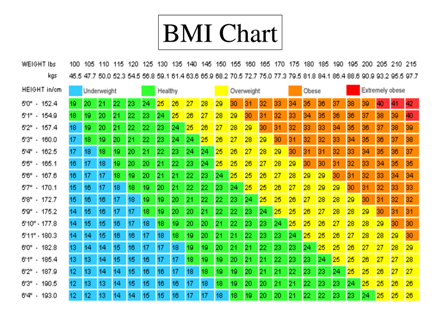FITNESS CHECK
| BODY MASS INDEX (BMI)
BMI is a reliable indicator of total body fat, which is related to the risk of disease and death. The score is valid for both men and women but it does have some limits. The limits are:
BMI = Weight in kilograms / (Height in meters) 2
Use the BMI calculator or tables to estimate your total body fat. The BMI score means the following:
The body mass index (BMI) is a statistical measure of the weight of a person scaled according to height. BMI is calculated as the individual's body weight divided by the square of their height.
BMI is frequently used to assess how much an individual's body weight departs from what is normal or desirable for a person of his or her height. The excess weight or deficiency may, in part, be accounted for by body fat although other factors such as muscularity also affect BMI. |
 |
| BMI(kg/m2) |
| < 16.5 |
severely underweight |
| 16.5 to 18.5 |
underweight |
| 18.5 to 25 |
normal |
| 25 to 30 |
overweight |
| 30 to 35 |
Obese |
| 35 to 40 |
Clinically Obese |
| >40 |
morbidly obese |
The BMI normal range is not applicable to pregnant and breast feeding mothers.
Other Risk Factors
Besides being overweight or obese, there are additional risk factors to consider.
-
high blood pressure (hypertension)
-
high LDL-cholesterol ("bad" cholesterol)
-
low HDL-cholesterol ("good" cholesterol)
-
high triglycerides
-
high blood glucose (sugar)
-
family history of premature heart disease
-
physical inactivity
-
cigarette smoking
Big benefits of normal BMI
Bringing your BMI within advisable limits (<23) helps by
-
Preventing diabetes.
-
If you already have diabetes then it improves your sugar levels and also helps to bring down the diabetes medication.
-
Preventing blood pressure.
-
If you already have high blood pressure then it helps to better control your blood pressure and also to bring down blood pressure medication.
-
Preventing heart disease.
-
Preventing stroke.
-
Preventing certain types of cancer.
-
Preventing osteoarthritis (joint pains).
-
Normalizing cholesterol levels and normalizing deranged blood fat levels
(lipid profile).
-
Increasing your life expectancy.
-
Making you look younger.
-
Improving your energy levels.
WAIST CIRCUMFERENCE
It is the measurement of waist circumference.
Men : > 40 in (> 102 cm)
Women : > 35 in (> 88cm)
WAIST-TO-HIP RATIO (WHR)
A variety of other anthropometric measurements have been employed in the diagnosis of obesity. The waist hip ratio is a simple and fairly useful parameter. In man, fattends to be deposited more on the chest and the abdomen, while in women the tendency for fat deposition is more on the buttocks and thighs.
Ideal WHR Ratio for adults
For men a waist-to-hip ratio above 1.0 and for women a waist–to–hip ratio above 0.9 indicate obesity.
| Waist-to-hip ratio = |
Waist circumference (cm)
----------------------------------
Hip circumference (cm) |
IDEAL WEIGHT
Ideal weight (kg) = Height (cm)-100 |
BODY FAT PERCENTAGE
Body fatness is measured by determining the thickness of subcutaneous tissues at designated body locations (triceps, abdomen, subscapular and subcostal sites) by means of calipers.
| Classification |
Women (Fat %) |
Men (Fat %) |
| Fit |
21-24 |
14-17 |
| Acceptable |
25-31 |
18-25 |
| Obese |
32+ |
25+ |
Source
Srilakshmi .B 2003.Dietetics, New Age International (P) Publishers Ltd.Chennai.
http://www.doctorndtv.com/calculator/bmi_calculator.asp |

